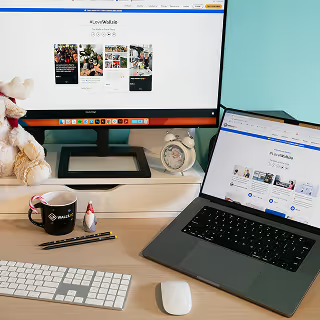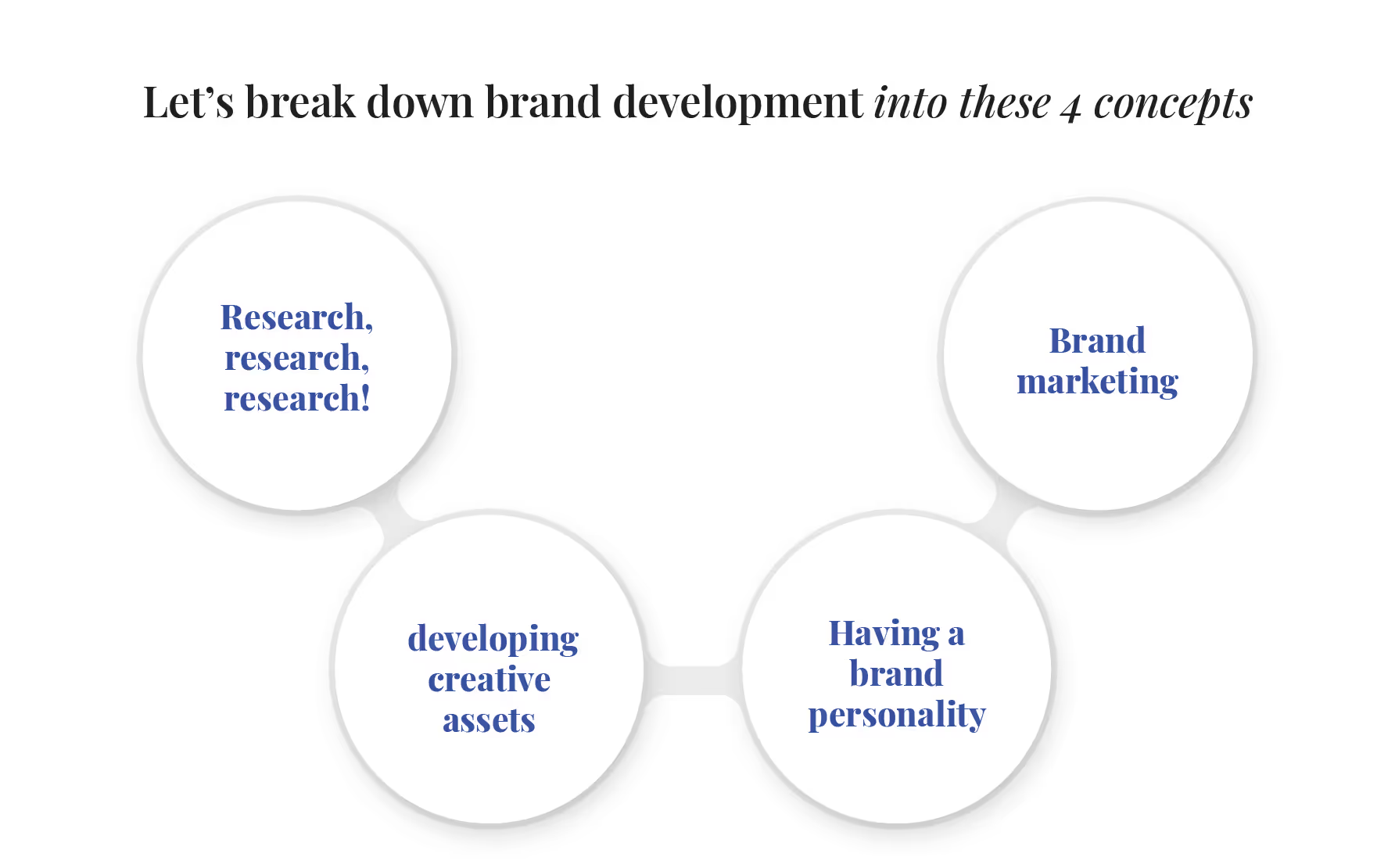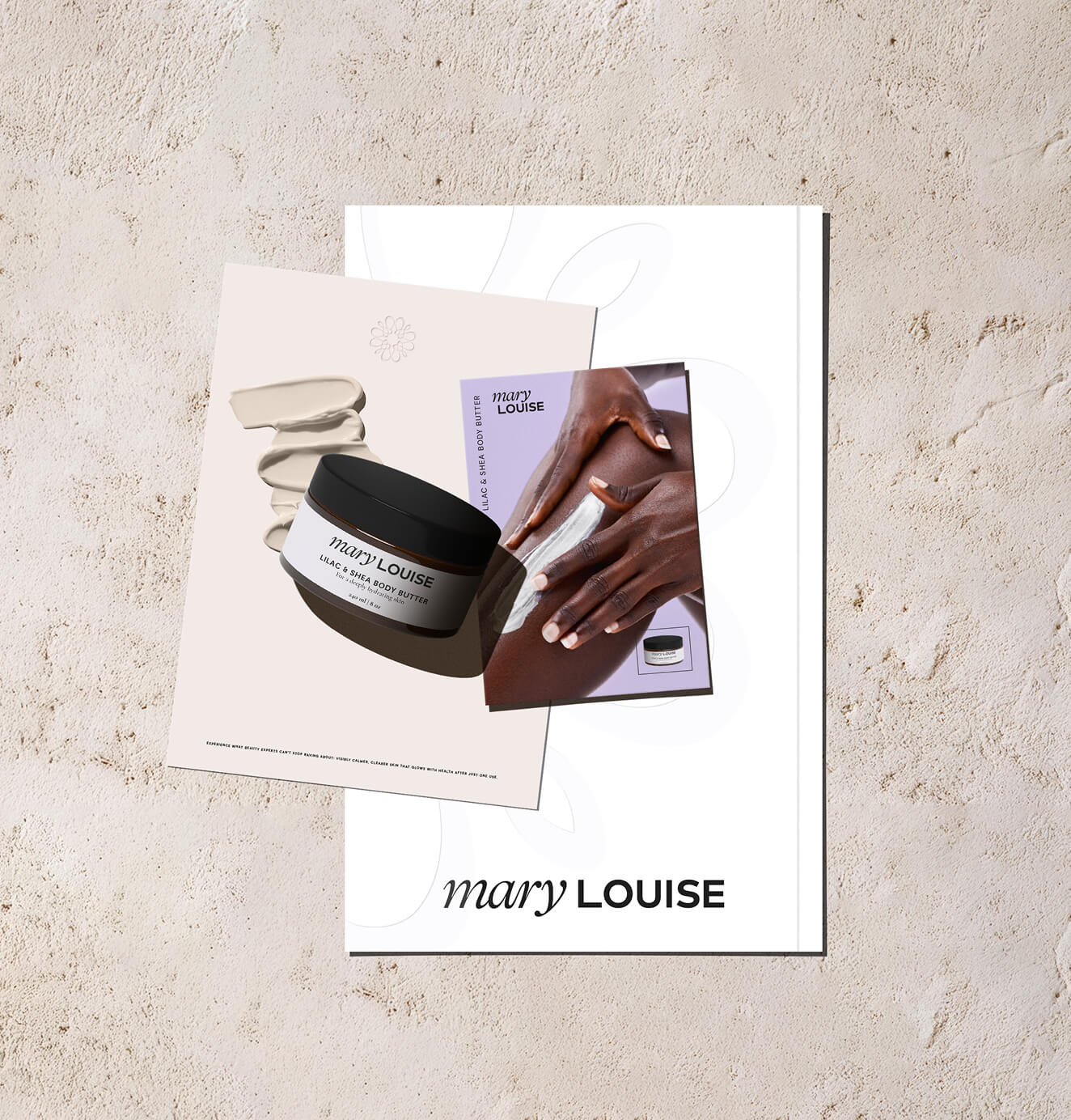Branding For Small Businesses
03/23/2025
Branding / Marketing Strategy
Strong branding can transform a small business into a recognizable and trusted name in any industry.

Are you a small business owner wondering how to compete with larger companies that have better branding, marketing and bigger teams and budgets? This blog post will answer all of your questions and more. Let’s take a deep dive into branding for small businesses and learn how a relatively small investment in branding can help you compete, win more customers and grow your business faster.
.png)


What does branding look like for small businesses?



Here are some tips to help you build a successful brand for your small business:
1. Know your target market. Before you start building your brand, take the time to understand who your target customers are. What do they like? What motivates them? By understanding their motivations and interests, you can tailor your branding efforts to speak directly to them.
2. Focus on quality. If you want your small business to be seen as a brand, then it’s essential that you focus on providing the best quality products and services possible. Customers will only return again and again if they are completely satisfied with what you have to offer.
3. Build a strong online presence. Today, almost everyone looks for businesses online first – so having an online presence is key to your branding efforts! Be sure to optimize your website and social media profiles, and invest in search engine optimization strategies so you can reach more customers through their searches.
4. Create a unique brand identity. In order to stand out from the competition, you should create a unique brand identity that helps you connect with your customers on a personal level. This can be something as simple as creating a tagline or having an identifiable color scheme that reflects your values and ethos.
5. Educate yourself about branding strategies. The more knowledgeable you are about branding strategies, the easier it will be for you to build a successful brand for your small business. Read up on different techniques and experiment with different ideas to find what works best for you.
With some hard work and dedication, you can build an effective brand for your small business – no matter how big or small it is!
Today, we’ll be giving you a full rundown of how to approach branding your small business, budget expectations, timelines and the impact branding your business will have.
The purpose of branding is to actively shape the consumer's perception of your company, product or service according to what you hope they think of when they interact with your brand.
If you're feeling a little overwhelmed... don't worry, we got you!
You might be wondering about the relationship between branding and marketing.
While marketing focuses on the promotion of products and services, branding is actually a subcategory under the larger umbrella of marketing that deals specifically with how your company wants to be perceived.
Brand strategy happens after you've conducted research on your target market - that way you know who you're speaking to when it comes time to create a brand identity or brand guidelines.
Although it is used interchangeably for a lot of people, it has specific definitions and uses behind it.
In contrast, marketing is about achieving short-term objectives.
It’s focused on generating sales, revenue growth, acquiring new customers and continuously expanding in the market field.
Even if the two concepts are opposing in some ways, an effective and successful marketing strategy implements and understands the interaction between marketing and branding.
While branding identifies your business products and services, marketing leverages your brand and promotes it across all platforms of communication.
Developing A Brand Identity for your Small Business












Having a brand identity means defining how your company looks, feels, and communicates with customers.
Ultimately, it affects how others see the credibility of your business and influences the entire customer experience.
There are a few key steps that you can take to develop an effective brand identity for your small business.
First, it's important to establish a clear and consistent branding strategy.
This can include things like choosing a specific color scheme or typeface that is used consistently throughout all of your marketing materials, or creating a memorable tagline or slogan that represents your business.
Another important step is to create high-quality content that accurately reflects your brand values and ethos.
This could include blog posts, social media updates, or other types of marketing materials that help you connect with customers on a personal level.
Finally, make sure to invest in branding tools like search engine optimization (SEO) and paid advertising to help ensure that your brand reaches a wide audience.
With the right marketing strategy, you can build an effective brand identity for your small business and reach more customers than ever before!

Research
Let’s start with research.
This is an important step in developing a brand identity so that you’re able to brand for your startup business.
One thing to look into is a buyer persona. Generally, a buyer persona, also known as consumer persona or audience persona is a hybrid of detailed market research and current information from existing customers that illustrates how you target your audience.
Basically, it is the task of portraying your ideal consumer.
Researching into your target audience is needed.
Your research should answer all of the questions below:
- Who your target audience is (primary, secondary, and tertiary audiences)
- What are your target customers demographics, geographic, psychographics and behaviours?
- What do they need?
- What problems do they have?
- What is the solution to their problems?
- Why do they need this solution?
- What motivates them?
- What are their core interests?
Identify your direct and indirect competitors, create brand positioning maps to analyze and compare each competitor and how they are positioned.
Create a SWOT analysis for each competitor to better understand how you measure up against each of them and identity any and all opportunities.
Depending on what product or service you provide, it’s essential that you see the strengths you have, what you can improve on and how you can be better than the rest.
Your research should answer all of the questions below:
- What is the unique value proposition of each competitor?
- What are your competitors key messages?
- What is their branding and marketing strategy?
- What is their brand personality like? Is it formal, casual, friendly?
- Is it catered to a specific niche audience, similar to yours?
Research into what the public says about you or those working in your team.
You want to make sure you’re taking the time to listen to how they perceive your brand.
Their perspective is something to seek because they’re essentially helping build the brand.
In short, they are the brand.
Here are some questions to help you get your research going:
- What are the positives? What can be improved?
- How do they see the business shaping up?
- Does your brand vision match the brand perception?
- Does anything need to change?
- Are more branding and marketing services needed?
Another thing to research is current trends in the marketplace. You want to be able to keep up with big updates.
Creative Assets
To develop your brand identity, you need to design and create assets.
What are creative assets?
Here are a few examples of creative assets:
- Logo
- Tag line
- Brand colours
- Typography
- Iconography
- Patterns
- Shapes
- Photography
It’s best to keep this all in your brand identity guideline.
You can also check out our blog post, all about brand bibles.
We include examples there to make it easier for you!
A visual identity is crucial to create cohesion and consistency with your small business.
This also creates a level of trust with your target audience.
They’ll expect these creative assets, and it’s what they’ll look for.
For example, in our previous blog post, we talked about the importance of logos, as they are usually the first contact, the first impression you make to the public.
Brand Personality
Boring doesn’t work too well with branding.
Even a subtle attitude or personality can make your brand pop.
Think of adjectives that might describe your business, and use those as the basis for your proposal.
There should be a personality behind your brand.
It might be whimsical or serious, traditional or adventurous, whatever it is–make sure you convey it through your communication, visuals and overall marketing strategy.
Your personality impacts your branding strategies significantly.
Here is a brand personality guideline to help you further develop this aspect so that your brand identity can come into full swing.
If you understand your brand personality, you will be able to create a consistent and authentic message across all of your marketing communications, whether it's through your logo, your business cards, or your social media interactions.
Here are some questions to look over:
- What is your brand vision and mission?
- What are you prioritizing in your brand?
- What qualities or words match the business?
- If the brand were a person, how would they come across? How would they look and sound?
Brand Marketing
We’ve gone over research, creative assets, brand personality in terms of developing a brand identity.
But something is missing from that mix! It’s brand marketing.
To grow your business, you need to market your brand effectively.
You can differentiate yourself from your competitors within the market if you have a strong, identifiable brand with a consistent identity across all your marketing activities.
In addition to giving the company a competitive edge, this gives it credibility when entering the market.
How can you market your brand?
There are hundreds of ways, that’s why brand strategy is the key.
Connect with us so we can talk about it more!
We’ll be sure you talk strategy with you.
Onto brand marketing tips...
Want to learn more about brand platforms, Brand Strategy and Brand Identity? Keep reading!
If you need help with your companies brand strategy and identity, contact us for a free custom quote.
5 Branding Tips For Small Businesses


What is brand purpose?
Defining brand purpose can be challenging because it is more than simply what your company does or how you do it.
Brand purpose goes beyond business objectives and serves as a guiding force for all aspects of your company and its interactions with customers, stakeholders, and other businesses.
Knowing your brand purpose is the first step to branding your small business.
Without your purpose, your branding and marketing strategies will fall flat.
You don't want to start something without a purpose, right?
Take some time to reflect on what you want your brand to represent and what the purpose is.
One step you can take to help you with your brand purpose and creating a purpose statement is to identify the problem that exists for your customer and the solution you will be providing, this will help you understand your brand purpose and your reason for existing.
It will be beneficial for you to understand brand pillars as well.
Also, start thinking about your brand objectives!
Brand Voice
Your brand voice is an important aspect of your brand and shouldn’t be overlooked.
Your brand voice should be genuine, friendly, casual and at times funny, these characteristics are commonly used by most brands as it resonates with the largest audience.
You need to be consistent with using your brand voice, this will helpyou build trust with your audience, which will help you generate more leads, more customers and more revenue.
For more details on how to create a brand voice, please see our brand voice guidelines.
Here’s another one to really let you see the importance of a consistent brand voice.
With your brand voice selected, you can develop a narrative that resonates with your target audience.
All of your communication methods, including your website and social media posts, should follow these core elements.
Brand Guidelines
Your brand guidelines are a set of rules and principles to follow, they will include visual and non-visual aspects of the brand.
Your brand will evolve overtime, people change, technology changes, everything changes and evolves and so your business and brand must evolve with the changing times.
So, with all of this change, you need to remember to keep your brand guidelines up to date.
Social Listening
Social listening is a term you may be unfamiliar with. So, read on!
When branding your small business effectively, you’ll realize how quickly social listening is important.
You can use social listening to find out what your customers are thinking by watching your social media platforms.
You can also learn about how your audience sees your brand - and understand them on a deeper level.
Social listening involves:
- Monitoring competitor mentions, social media mentions, keyword mentions, etc.
- Customer reviews (positive and negative): responding to them and learning from them
- Taking notes, gaining knowledge from what you’re seeing
Rather than primarily monitoring social mentions, social listening is about getting information about what is happening on your brand.
Social listening aims to understand consumer perceptions and moods concerning the brand.
Boost Your Brand
It’s time to hype up your brand!
Promote it the best way you can, and if you need help getting the word out there, or if you need further marketing services, you can always count on us!
Social media is the best place to start.
Reaching out to family and friends is a great idea, too!
Start small and build upon your online profiles.
You want to gradually introduce your brand and create curiosity around it.
You can provide easy-to-use information about what your business does for consumers on a clean, user-friendly website.
Ensure that the call-to-action points people in the right direction!
Think of the words: Connect With Us, Schedule a Call and Sign Up to use.
Also, be honest with your audience about what you want to achieve–they’ll more likely form a bond and trust with your brand.
After that, you'll want to create a marketing plan.
Here are marketing strategies for millennials and another, for Gen Z. We told you we got you covered.
How small service based business should brand their business
Branching out on your own and launching a small service-based business can be both exciting and challenging.
To effectively brand your business, it is important to start by understanding your target audience and developing a clear brand strategy based on their needs and preferences.
In addition to identifying your core values, mission, vision, and purpose, you should also focus on budgeting and promotion: One of the most important branding strategies for small businesses is to carefully manage your budget.
This means identifying the most cost-effective marketing and advertising channels, as well as setting realistic goals based on your budget and resources.
It is also essential to utilize social media platforms and other online tools to connect with potential customers and promote your business.
Branding has multiple layers, each of which has its structure and meaning.
Marketing is not the same as branding, but the two concepts share many common themes.
Each concept works closely with the other and has the same primary goal: serving the business.
Now that we’ve covered 5 branding tips for small businesses and how to develop a brand identity, you can feel confident that you’re equipped with the knowledge that will take you further in your small business journey.
Here are some very specific step by step branding guides for: Real Estate, Lawyers, Accounting, Doctors, Dentists, Optometrists, Jewellery, Makeup & Beauty, Skincare, Pet Food, Fashion and Construction.
If you need help writing a business plan for your startup, checkout our guide here https://www.brandedagency.com/blog/writing-a-business-plan-guide
Connect with us, and let’s talk branding.
What is branding for a small business? Answer: Branding for a small business is the process of creating a unique identity for your business that distinguishes it from competitors and helps to create a memorable and recognizable image in the minds of customers.
FAQ: Small Business Branding

Why is branding important for a small business?
Answer: Branding is important for a small business because it helps to establish credibility and build trust with customers. A strong brand can also help to attract new customers and retain existing ones.
How do I create a brand for my small business?
Answer: To create a brand for your small business, you need to start with understanding your target audience, defining your unique selling proposition (USP), and developing a visual identity that reflects your brand personality and values.
What are the key elements of a strong brand?
Answer: The key elements of a strong brand include a clear and concise brand message, a unique visual identity, a strong brand personality, and consistent branding across all marketing channels.
How do I ensure consistency in my branding efforts?
Answer: To ensure consistency in your branding efforts, you should create a branding style guide that outlines your brand voice, visual identity, and other key branding elements. This guide can be used to ensure consistency across all marketing channels.
How can I measure the effectiveness of my branding efforts?
Answer: You can measure the effectiveness of your branding efforts by tracking metrics such as brand awareness, customer loyalty, and sales growth. You can also conduct market research to gather feedback from customers.
How do I rebrand my small business?
Answer: To rebrand your small business, you should start by conducting market research to identify areas for improvement. You should also define your new brand strategy, develop a new visual identity, and communicate your rebranding efforts to customers.
How do I choose the right brand name for my small business?
Answer: To choose the right brand name for your small business, you should consider factors such as brand differentiation, memorability, and domain availability. You may also want to conduct a trademark search to ensure that the name is available for use.
How do I choose the right brand colors and fonts?
Answer: To choose the right brand colors and fonts, you should consider your brand personality and values, as well as the preferences of your target audience. You should also consider the legibility and readability of your chosen fonts.
How do I integrate my brand into my overall marketing strategy?
Answer: To integrate your brand into your overall marketing strategy, you should ensure that all marketing materials, including social media posts, website content, and advertising, are consistent with your branding guidelines. You should also consider ways to leverage your brand to attract and retain customers, such as through brand partnerships or influencer marketing.

Sloane Avery
As entrepreneurs, they’ve built and scaled their own ventures from zero to millions. They’ve been in the trenches, navigating the chaos of high-growth phases, making the hard calls, and learning firsthand what actually moves the needle. That’s what makes us different—we don’t just “consult,” we know what it takes because we’ve done it ourselves.
Want to learn more about brand platform?
If you need help with your companies brand strategy and identity, contact us for a free custom quote.
We do great work. And get great results.
+2.3xIncrease in revenue YoY
+126%Increase in repurchase rate YoY








+93%Revenue growth in first 90 days
+144% Increase in attributed revenue








+91%Increase in conversion rate
+46%Increase in AOV








+200%Increase in conversion rate
+688%Increase in attributed revenue












